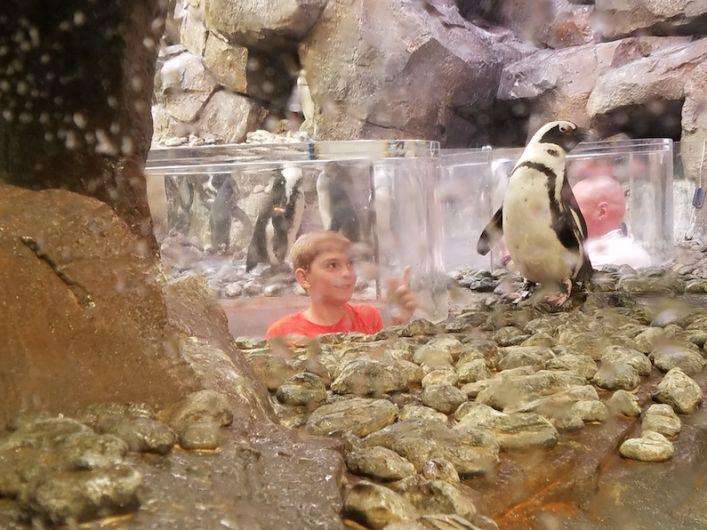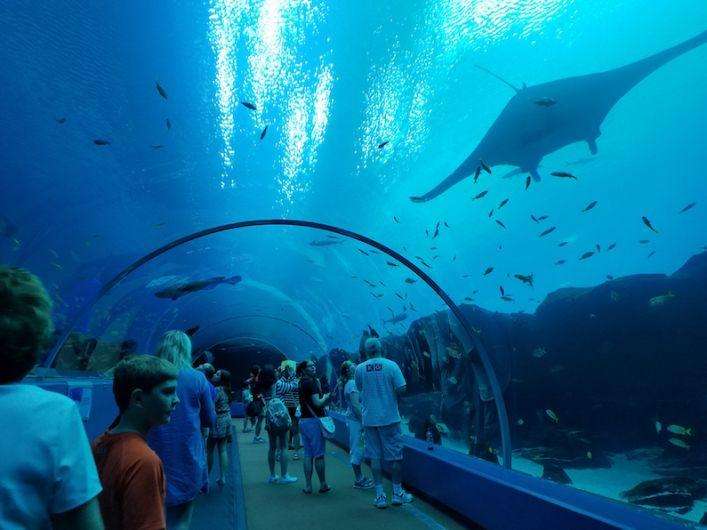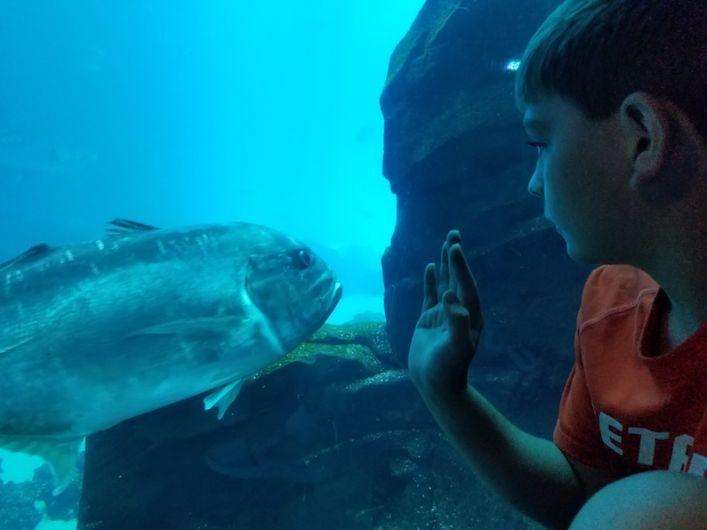The Georgia Aquarium belongs on your RVing Bucket List. Here's why…
Right off I-75 in downtown Atlanta is the Georgia Aquarium, the largest aquarium in the Western Hemisphere. It has 10 million gallons of fresh and marine water and tens of thousands of animals.
We heard great things about it for several years before getting the chance to take our grandson, Jacob, for a visit. We were blown away by the quality exhibits and size.
For RVers, the only downside is parking.
The parking deck attached to the aquarium is enclosed and too low to accommodate even Class B RVs. There are a couple of open-air street lots within an easy walk that will do just fine for Class B and C units. None can handle Class A RVs.
Corporate-Funded Origins
It's a fairly new aquarium, opening in 2005. Its origins go back to November 2001, when Home Depot co-founder Bernard Marcus announced his vision of presenting Atlanta with an aquarium that would encourage both education and economic growth.
After visiting 56 aquariums in 13 countries with his wife, Billi, he donated $250 million toward what was to become Georgia Aquarium. Corporate contributions totaling an additional $40 million allowed the aquarium to open debt-free.
Georgia Aquarium Exhibits
The most notable exhibit is the massive 6.3 million gallon tank containing four whale sharks, taken from Taiwan's annual fishing kill quota. They would have been eaten had they not been purchased by the aquarium.
Since 2007, a ban on whale shark capture has been in effect, making the Georgia Aquarium the only institution outside of Asia housing the species. These local animal ambassadors are now helping educate visitors about how they can help whale sharks and protect sea life.

The whole aquarium was built around the whale shark exhibit, with tunnels, walk-in windows, and a huge 30 foot high plexiglass wall allowing for very up-close observation. The whale sharks cruise with giant manta rays, sharks and dozens of other species.
Belugas
Another exhibit and another tank holds several beluga whales, distinctively white and as long as 11 feet.
An interesting fact I learned is that belugas can swim backward, which helps them navigate icy waters. They also have a very diverse diet. They are considered ‘opportunistic eaters,' meaning they'll eat pretty much anything that they can find. That sounds like me when I'm hungry late at night!
Dolphins
The aquarium is also home to a family of common bottlenose dolphins. Like most people, I'm a sucker for their playful antics and smiling faces. But they're not there to entertain; they're there to educate.
The Dolphin Coast gallery presents fun marine facts, a live training demonstration, and educates visitors on the Aquarium's efforts to preserve the species. You can pay $5 if you want to skip the lines and get preferred seating.
If you're looking for a great souvenir, you can take home a painting by these dolphins. That's right, these dolphins paint. And so do the belugas! You can order dolphin paintings and beluga paintings online.
Penguins
The penguins are also a favorite among visitors. Our grandson even made a penguin pal that kept waddling by him.
These penguins are African penguins. They are from the rocky coasts of Namibia and South Africa. In the wild, they sometimes swim as far as nine miles off the coast on their hunting exhibitions.

Other Exhibit Galleries
Other popular exhibits and galleries include:
- California Sea Lions
- American Alligator
- Aquanaut Adventure
- Cold Water Quest
- Ocean Voyager
- Sharks! Predators of the Deep®
- Southern Company River Scout
Georgia Aquarium Hours and Pricing
The Georgia Aquarium is open most days from 9 am to 6 pm. Times can vary so be sure to check the website for your visit date.
There's a dolphin show, a 4D movie, and lots of educational talks and presentations. Plan on spending at least four hours to take it all in.
And plan on spending lots of money. Adult tickets cost $36.95. Seniors are charged $32.95. Kids are $30.05.
You can order online and select an arrival time for your visit.
Expensive it is. But it's worth it. We'll be back. Several times. It's that impressive. If you've never been there, put it on your bucket list.
If you're headed south to Florida, check out this RV Adventure Guide bundle…
Mike and Jennifer's Favorite Places in Florida – all 3 ebooks!

We RVers may wander far and wide but it’s true for most of us that we end up with some favorite “Go-To” places – places that draw us back again and again.
Florida is one of those places for us. And we know it is for many RVers looking to get away and explore during the winter.
That's why we've created three guides, covering Florida's Atlantic Coast, the Gulf Coast, and the Keys.
Each of these guides is a seven-day guided exploration of one of the coasts. And each stop is a curated view of the best things that we’ve enjoyed on this trip and want you to experience.
Altogether these guides are over 300 pages of content!








Leave a Reply